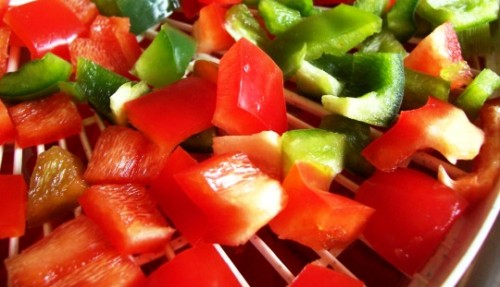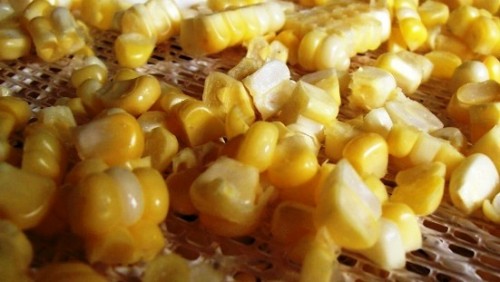5 Reasons Why Dehydration is a Great Method of Food Preservation

So far this year I have dehydrated blueberries, cherries, apples, eggplant, summer squash, sweet corn, bell peppers, tomatoes, and herbs and spent much less time and space than if I had canned or frozen them.
This is the first year I have spent any time or energy preserving the harvest. I have enjoyed it immensely and learned a lot, though I still have much more to learn. I have canned, lacto-fermented and dehydrated food this year and find dehydration to be one of the simplest and easiest methods.
There are many benefits of this method of food preservation. Dehydration…
1. Does Not Require Electricity.
Most of us are familiar with electric dehydrators seen on infomercials and in stores. But long before any of us came up with those devices people were drying food for the winter. Native Americans dried strips of meat over campfires to take with on hunting trips. Herbs have been put in bunches and hung upside down to dry for centuries in Europe and all over the world. We have been using an electric dehydrator this year, but my husband hopes to build a solar dehydrator similar to David’s someday.
2. Is Less Time Consuming.
I find canning to be quite the process with all of the washing, sterilization, boiling water, and preparing of jars, lids and food. It doesn’t help that I’m a novice, but I do find that drying requires less hands-on time and less preparation. Simply chop, blanch if necessary and place on the trays of your dehydrator and let the sun (or electricity) do the work. Cleaning the trays afterward is the only seemingly big job.
3. Makes Winter Meals Easier.
Now that I am seeing bags and jars of dehydrated foods I am imagining all of the soups, stews, chilis and other meals that will come of them. How much simpler can it be to throw together a meal when the vegetables are already chopped for you?

4. Requires Less Storage Space.
I like to store the dried food in either glass jars (my preference) or resealable bags. When you dehydrate you remove the water content, which for a tomato can be upwards of 95%. So you are storing the same amount of food, minus the water content that you will replace later, only using much less space.
5. Is Child Friendly.
So far I have been unable to come up with a way to incorporate my 3 year old into canning. He usually helps me with all sorts of kitchen and household duties, but with all of the boiling water and hot jars it just doesn’t seem feasible to me at this age. Dehydration, on the other hand, is fun to do with him. Once his hands are washed he is able to place cut up fruits and vegetables on the trays and then remove them and place them in jars or bags when they are done. He loves helping with it and I love that he is working beside me the whole time.
Resources
The book Preserving Food Without Freezing or Canning is what initially turned me on to dehydrating food. I would highly recommend that book as well as finding a book solely dedicated to drying food. I found an old book that it is out of print at a book sale that goes through the best ways to dry each food, including meats, and how to use them once dried. It has been a great help.
If you are looking for an electric dehydrator you can find them and various other kitchen equipment on my resources page.




I’ve often thought about dehydrating, but I’ve never gotten around to trying it – I suppose because I was already familiar with canning. But, you’ve rekindled my interest. I know we have an electric dehydrator somewhere…
I love my dehydrator! I like drying cherry tomatoes rather than freezing them because the dried ones can be easily added to salads. I’ve been drying apple slices this year with plans to turn them into pies, cakes and other desserts. Since we make a lot of sauce, we prefer canning our plum tomatoes rather than drying them. I also tried drying swiss chard and kale this year so that I can add it into dishes. As long as the dish is dark in color, none of my kids have noticed! My only failure is making fruit leather. I don’t think I made mine thick enough.
Hi, cool post. It reminds me of another recent dehydrator article at wisebread: http://www.wisebread.com/9-money-saving-reasons-to-buy-a-food-dehydrator
Your “child-friendly” reason is a good one. I think it also gets them thinking about healthier snacks, ones they make themselves.
I’ve tried the oven and the sun, but a food dehydrator works the best, is the most consistent in thoroughly drying food.
I am anxiously awaiting the arrival of my dehydrator once our household goods finally arrive. This evening the novel idea dawned on me that not only can I dehydrate for food, but also for a few home decor projects as well. Some bruised, fallen apples could be salvaged by being dehydrated into apple wreaths, one for me and one for my grandmother’s birthday in November. 🙂
Sarah cans with me. By this I mean she works in her little wooden kitchen, placing her wooden fruit and veggies into mason jars, putting the lids on, and then placing the jar in her little metal stockpot and “pozezzing” them. She began doing that one day when I wasn’t even canning and has since graduated to dehydrating food in her oven as well. If I’m not careful, she’ll soon be a more accomplished homemaker than I am!
I am in the process of dehydrating apples and we love it! So easy and satisfying.
Great post! I grew up dehydrating foods (though I don’t have one now) and eating a lot of homemade jerky and salami, both dehydrated and oven dried, along with apples, peaches, nuts and more. I’ve even made dehydrated “meals” for my dad for hunting . . . I bought a book about it once (that I gave to him) but I’ll have to see if I can find it . . . makes those individually packaged dehydrated meals at places like REI feel shamed! 🙂
I’ve had that book you mention on my amazon list for a while; a book review would be lovely! 🙂
Best,
Sarah
Okay, I’m back . . . I think the book is called “Backpack Gourmet.”
http://www.amazon.com/Backpack-Gourmet-Dehydrate-Healthy-Eating/dp/0811726347/ref=sr_1_43?ie=UTF8&s=books&qid=1253912676&sr=1-43
Best,
Sarah
I just bought my dehydrator from Craig’s List for $20!! I was excited and made fruit leathers right off the bat. Tasted great but didn’t make much 🙁 I’ll have to try more trays next time & a way to make them thicker. Thanks for the book suggestions!
I have an Excalibur but have to admit I’ve never used it with the intention of preserving food. How do you use your dehydrated chopped veggies? Rehydrate and use like usual? Or I suppose they’d be best in soups and stews? Interesting…
Agree on the kids part, my children love their dehydrated jerky.
Can’t even recall how I clicked through to get here. I think I get your emails, so must’ve clicked a link from those. Anyway, thanks for the inspiration to try dehydrating. I’m looking at the excalibur… we’ll see what my husband says! I love the idea of taking up less space yet still preserving. Off to make some sauerkraut!
Great post, I’m pretty sure our story will fit in here 🙂
We are a students start-up with a solar food dehydration device, the “Solpod”. We are using our device to help farmers in Africa that can’t preserve their food because they can’t afford electricity.
Our dehydrator only uses the sun heat and is 100 times faster their traditional technics.
We need votes for our project please click the vote button on this link: http://www.dellchallenge.org/projects/jola-venture
Don’t hesitate contacting me: orphee@jolaventure.com
I have 2 dehydraters, but haven’t used either of them for years. I recently started reading a “survival” site, which led me to ways to preserve food…… which led me to you. After reading all the comments, I can’t wait to take my dehydraters down and put them to use! I suscribed to your email newsletter and look forward to more tips and do’s and don’ts. Thanks so much!.